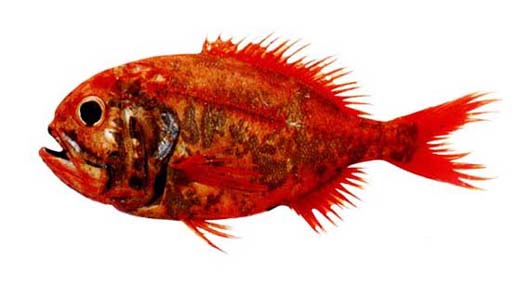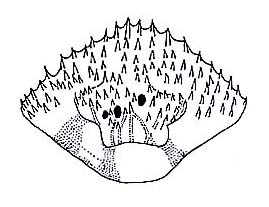ヒウチダイ科
- HOME
- デジタル図鑑
- パタゴニア海域の重要水族
- 硬骨魚綱 キンメダイ目
- ヒウチダイ科
ヒウチダイ科(Trachichthyidae)

54 オレンジラフィー(Orenzi-rafii)
Hoplostethus atlanticus Collett, 1889
Orange roughy, Deep sea perch (NZ.); Red roughy (Aus.); Kaiserbarsch (Ger.)
ヒウチダイ(業界名)
特 徴:
背鰭5棘,17〜18軟条,臀鰭3棘,10軟条,胸鰭19〜20軟条,腹鰭1棘,6軟条,鰓耙数6+1+13〜14=20〜21,鰓条骨数8,側線鱗数31。頭長は体長の35.1〜36.9%,眼径は7.5〜8.6%,体高は44.1〜45.9%,吻長は9.7〜10.7%,両眼間隔は12.3〜12.9%,上顎長は24.0〜25.5%,尾柄高は9.7〜10.9%,胸鰭長は24.4〜26.3%,腹鰭長は18.1〜29.4%。体は卵円形で,体高は高く,著しく側扁する。頭は大きく,体長は頭長の約3倍。頭部は骨質隆起でおおわれ,各隆起間は半透明の膜でおおわれる。口は大きく斜位,上顎後端は眼窩後縁下に達する。口を閉じた場合,両顎は前方で同等。両顎と口蓋骨に絨毛状歯帯がある。鋤骨は無歯。眼は大きく,頭長は眼径の約4倍。一対の鼻孔は吻端より眼に近く位置し,前鼻孔は丸く,後鼻孔は楕円形。前鰓蓋骨の隅角部に弱い棘がある。鰓条膜は後端部で鰓蓋と分離し,峡部からも分離する。第1鰓弓上の鰓耙は細長くて,中央部に微小な鋸歯縁がある。体と頬に脱落し易い小円鱗が分布する。側線鱗は他の鱗より大きくて頑丈。側線は単線で,直線状に斜に主鰓蓋骨上方から尾鰭基底部まで走る。胸鰭はやや長く,頭長は胸鰭長の約1.5倍。腹鰭は短く,先端は肛門に達しない。背鰭と臀鰭の棘は強い。尾鰭起部前縁に数本ずつの小棘がある。体は赤味を帯びる。
分 布:
アイルランドからヘルゴランドを経て南アフリカの喜望峰付近に至る大西洋(Woods and Sonoda, 1973);オーストラリア南部,ニュージーランドからも知られている(谷津,1985)。Bahamonde and Peque‾no (1975)は本種を記録していないので,今回のチリからの報告は初記録と思われる。
備 考:
生息水深はニュージーランド近海では780〜1,200m,主として840〜990m(Robertson and Grimes, 1983)。
(中村 泉)
Material examined:
3 from Chile (232.3-283.7 mm SL), FAKU S 602, 603; CP 213.
Description:
D Ⅴ, 17-18; A Ⅲ, 10; P1 19-20; P2 Ⅰ, 6; GR 6+1+13-14=20-21; BR 8; LLS 31. HL 35.1-36.9% of SL; ED 7.5-8.6; BD 44.1-45.9; SN 9.7-10.7; IO 12.3-12.9; UJ 24.0-25.5; CP 9.7-10.9; P1L 24.4-26.3; P2L 18.1-29.4.
Body oval, deep and remarkably compressed. Head large, about 3 times in SL, with conspicuous cavities surrounded by bony ridges and covered by thin membranes. Mouth oblique, large, posterior end of upper jaw reaching to below posterior margin of orbit, jaws equal when closed. Villiform teeth in bands on jaws and palatines. Vomer edentulous. Eye large, about 4 times in head. Two large nostrils, situated nearer to eye than to tip of snout, anterior nostril circular, posterior nostril elliptical. A week spine at angle of preopercle. Gill-membranes separate from gill-cover distally and free from isthmus. Gill-rakers on first arch long and finely serrated medially. Rather small, deciduous, ctenoid scales covering body and cheek; lateral line scales larger and stouter. Scutes along belly feeble, indistinct. Lateral line distinct, running in an straight line, obliquely from above upper margin of opercle to caudal fin base. Pectoral fin rather long, about 1.5 in head. Pelvic fin short, not reaching anus. Dorsal and anal fin spines pungent. Procurrent caudal fin spinous. Body uniformely reddish.
Distribution:
Atlantic Ocean, from Ireland and Helgoland to off the Cape of South Africa (Woods and Sonoda, 1973); South of Australia, around New Zealand (Yatsu, 1985). Bahamonde and Pequeño (1975) did not record this species in Chilean waters, so this seems to be the first record for Chile.
Remarks:
This species is easily distinguishable from two Japanese species, H. japonicus and H. crassispinus, which have fewer (12 or 13) dorsal soft fin rays (H. atlanticus, 17 or 18). The depth range caught is 780-1,200 m (mostly 840-990 m) (Robertson and Grimes, 1983)
(Izumi NAKAMURA)

Distribution of Hoplostethus atlanticus in Patagonia.

Lateral line scale.
- 1